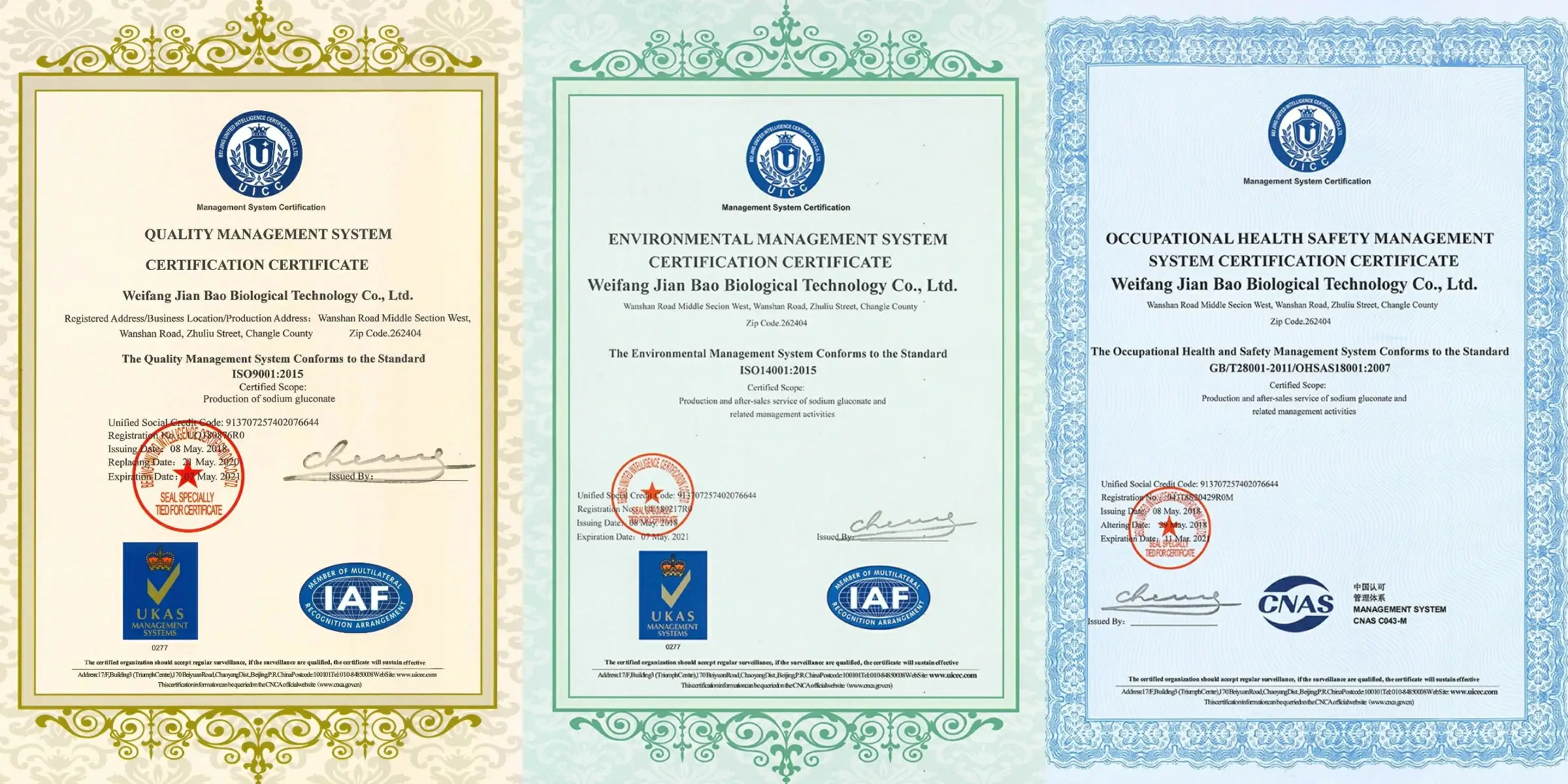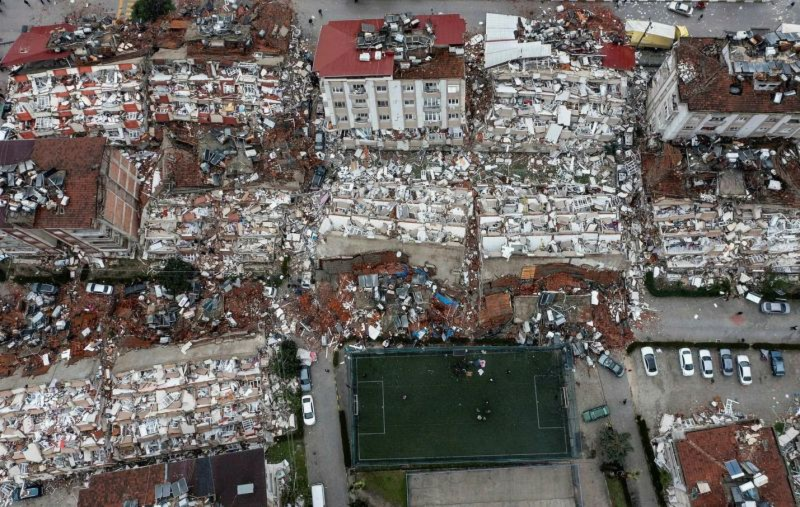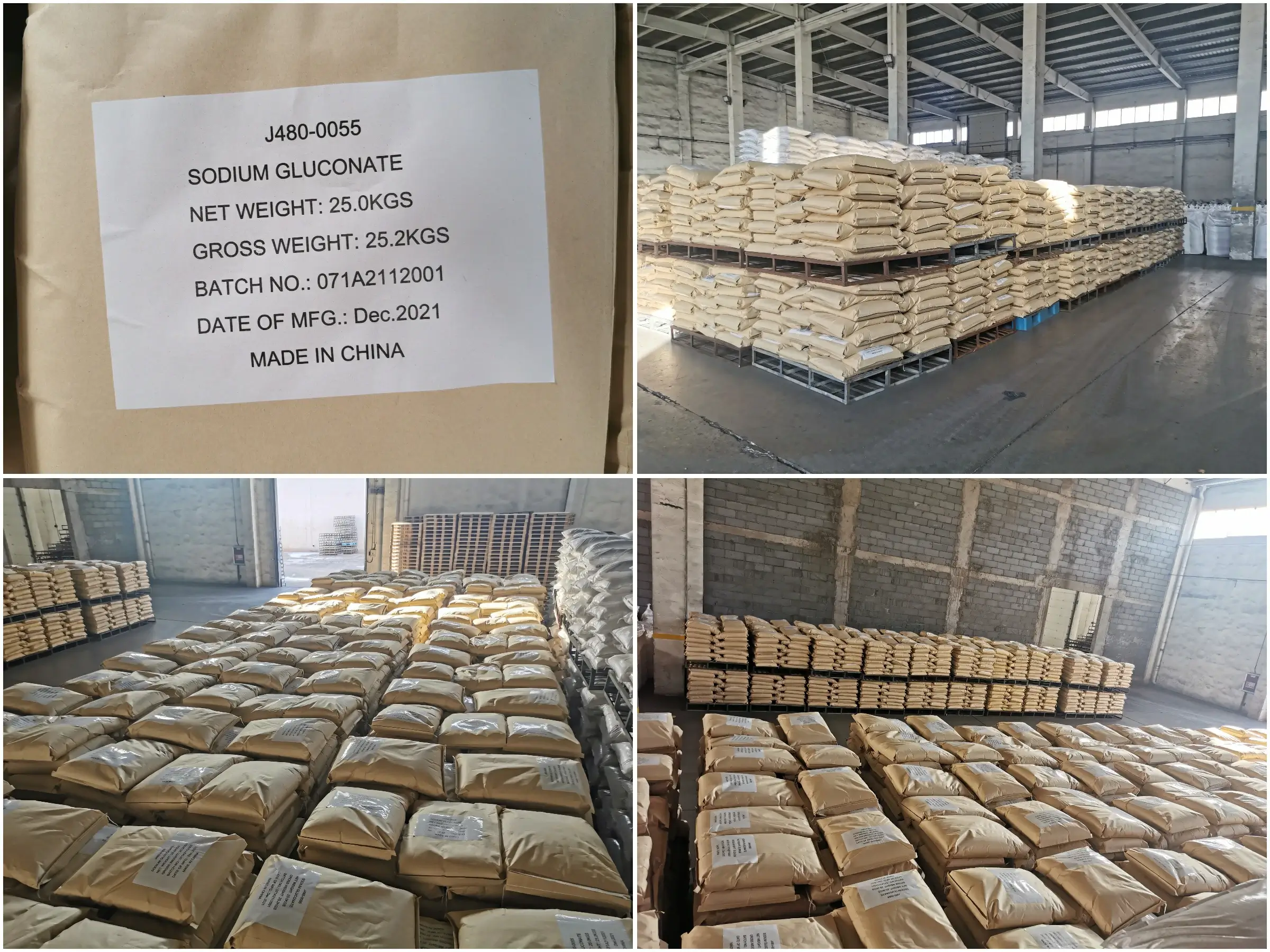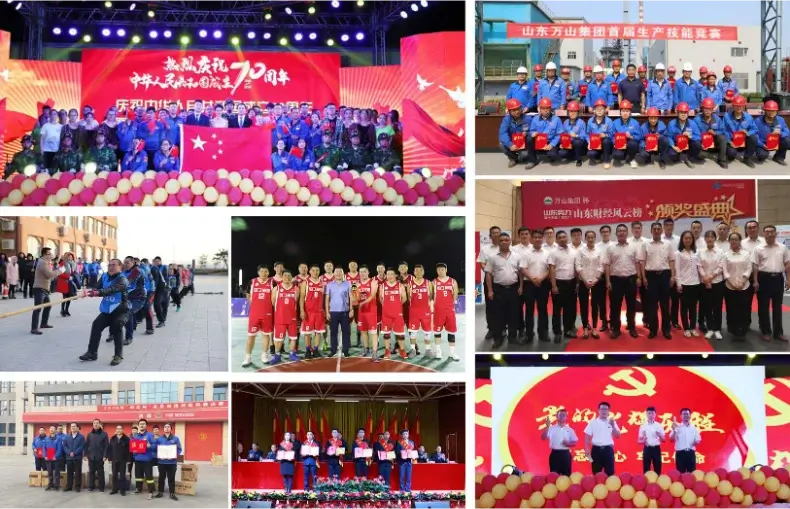b

Thank You!
Your requirement has been sent, we will contact you quickly!
Sent Failed!
Try again!
| Pallets Packing | 20'FCL | 40'FCL | ||
| With | Without | With | Without | |
|
25KG/Woven Bag
|
24 MT
|
26 MT
|
--
|
--
|
|
1000KG/Jumbo Bag
|
20 MT
|
--
|
--
|
--
|
| Pallets Packing | 20'FCL | 40'FCL | ||
| With | Without | With | Without | |
| 25KG/Woven Bag | 24 MT | 26 MT | -- | -- |
| 1000KG/Jumbo Bag | 20 MT | -- | -- | -- |
| 1100KG/Jumbo Bag | 22 MT | -- | -- | -- |
Weifang Jianbao Biotechnology Co., Ltd. is the largest sodium gluconate production base in China with capacity 105000mt annually. It is widely used as a superplasticizer and retarder in concrete.
Features:
Product Name: | Sodium Gluconate | CAS No.: | 527-07-1 |
Other Names: | Sodium D-Gluconate, D-Gluconate sodium salt, Na Gluconate | Certificates: | ISO9001, ISO14001, OHSAS |
Appearance: | White to light beige crystalline powder | Type: | Building Chemicals, Concrete Additive |
Shelf Life: | Two years | Assay: | ≥99%; ≥98% |
MOQ: | 26 Metric Tons | Grade Standard: | Tech Grade |
Place of Origin: | Shandong, China | Sample: | Available |
Usage: | Sodium Gluconate is mainly used as a concrete additive and plays the role of water reducer and retarder | ||

105000 Metric Tons Per Year
Packaging Details: | 25kg / Woven Bag, 1.1 Ton/Jumbo Bag |
Port: | Qingdao Port |
Lead time: | A week |
Specification of “≥ 98%” :
Test Item | Specification | Test Result |
Appearance | White crystal granule or powder Qualified | Qualified |
Soluble | Colorless or slightly yellow, almost clear | Qualified |
Smell | With the inherent special smell | Qualified |
Assay(%) | ≥ 98 | 99.6 |
Whiteness(%) | 75 | 80 |
Loss on drying (%) | ≤0.5 | 0.2 |
Reducing substances % | ≤0.5 | 0.3 |
Chlorider(CI-)% | ≤0.07 | 0.03 |
Sulphate% | ≤0.05 | 0.02 |
PH Value ( 10% solution ) | 6.5-7.5 | 7.2 |
Heavy metals ( pb ), mg/kg | ≤2ppm | <2ppm |
Arsenic mg/kg | ≤3ppm | <2ppm |
Specification of “≥ 99%” :
Name | Sodium Gluconate | Results |
Test Item | Standard Value | |
Appearance | White crystal granule or powder | Qualified |
Soluble | Colorless or slightly yellow, almost clear | Qualified |
Smell | With the inherent special smell | Qualified |
Assay(%) | ≥ 99 | 99.6 |
Whiteness (%) | 75 | 84.2 |
Loss on drying (%) | ≤0.3 | 0.15 |
Reducing substances(C6H12O6)% | ≤ 0.3 | 0.26 |
Chlorider ( Cl-)% | ≤ 0.02 | 0.02 |
Sulfate(SO42-)% | ≤ 0.02 | 0.02 |
PH Value(10% solution) | 6.2-7.8 | 7.6 |
Heavy metals(Pb),mg/kg | ≤5 | <5 |
Arsenic(As) mg/kg | ≤1 | <1 |
We are deeply saddened by the loss of life and the destruction caused by the recent earthquake in Turkey. The collapse of so many buildings is a shocking reminder of the need for safe and resilient structures.
While the reasons for building collapses during earthquakes can be complex and multifaceted, including factors such as building materials, construction methods, design, and site conditions, we would like to highlight a lesser-known factor: reinforcement corrosion caused by the presence of chloride ions in concrete. Chloride ions can be added to concrete as part of the sodium gluconate used as a superplasticizer. Unfortunately, some Chinese companies have added 10% NaCl to their sodium gluconate to make it cheaper, and some Turkish importers have purchased these lower-priced products without being fully aware of the potential detrimental impact on the building's durability and strength.

When chloride ions penetrate into concrete, they can corrode the reinforcing steel bars, leading to the degradation of the concrete structure and ultimately its failure. In addition to corrosion, chloride ions can also contribute to the scaling and spalling of concrete surfaces, reducing its ability to protect the reinforcing steel. This can result in the formation of cracks and pitting, which can accelerate the corrosion process and decrease the service life of the concrete structure. Reinforcement corrosion caused by chloride ions can be a slow and insidious problem, taking several years or even decades to develop. In many cases, the symptoms of corrosion may not become apparent until the concrete structure has already suffered significant damage. However, during an earthquake, the effects can be rapidly and dramatically magnified.
To ensure the safety and stability of buildings, it is important to use high-quality sodium gluconate without added NaCl in concrete mixtures. Additionally, it is important to monitor concrete structures for signs of corrosion and to make repairs as needed to prevent the ingress of chloride ions.

Weifang Jianbao Biotechnology Co., Ltd. is mainly engaged in sodium gluconate. It is located in Changle County, Weifang City, Shandong Province and belongs to Shandong Wanshan Group.

The factory covers an area of more than 130 acres, with a construction area of more than 50,000 square meters. The project has advanced equipment, mature technology, clean and environmental protection, adopts advanced biological fermentation technology, and realizes fully automated control from raw material input, production process control, and product packaging storage. It is currently the industry's most self-determined production process system.


The project's "Technology Center" and "Key Laboratory of High-end Auxiliary Agents" were identified as municipal-level technology R & D platforms and were included in Weifang City's "invisible champion" cultivation enterprise.


Sodium Gluconate has a wide range of applications.
1) Sodium Gluconate could be used in the food industry. Sodium gluconate can replace salt and improve food flavor.
2) Sodium Gluconate could be a chelating agent in the construction, textile, metal surface dealing, and water treatment.
3) Sodium Gluconate could be the cleaning agent for the steel, and glass.
4) Sodium Gluconate could be the electroplating industry aluminum oxygen coloring agent.
5) Sodium Gluconate could be the high-efficiency concrete retarder & concrete superplasticizer in the concrete industry.
1) Sodium Gluconate Set Retarder in Concrete
Sodium gluconate for concrete can significantly delay the setting time of concrete. When the amount of sodium gluconate is 0.15% or less, the amount of sodium gluconate in concrete is double, and the time of concrete initial setting will be delayed by ten times. This prolongs the work time of concrete from a few hours to a few days without losing its strength.
Nowadays, the concrete in many places is transported to the construction site after mixing in the plant area. If the concrete solidifies during this period of time, the construction will not be carried out. At this time, it is necessary to add sodium gluconate admixture to the concrete. Because it can retard the concrete and enhance its plasticizing performance of the concrete.
In addition, due to the large volume of the infusion project, it is difficult to construct. Adding sodium gluconate to concrete can improve the working performance of concrete and delay the setting time of concrete. Thus avoiding the formation of joints on the structure and improving the structural strength. That is conducive to the implementation of large-volume perfusion projects.
2) Sodium Gluconate as Water Reducer
As a water-reducing agent, sodium gluconate can make concrete mixes have better processability and increase concrete slump. By adjusting the water-cement ratio and adding sodium gluconate, the strength of the concrete structure can be enhanced. Besides, the cement content can be reduced while maintaining the original strength of the concrete. By adding sodium gluconate to the concrete, you can get the following results:
1. Reduce cement and water. The addition of sodium gluconate can reduce the cement content to the same proportion of water consumption. The overall water-cement ratio of the concrete remains unchanged.
2. Improve the strength of concrete. When the cement content remains constant and the water content of the concrete decreases. With 0.1% sodium gluconate added, concrete water consumption can be reduced by 10%.
3. Improve the workability of concrete. When the water-cement ratio is constant, the addition of sodium gluconate can improve the workability of concrete.

As a concrete admixture, sodium gluconate has many benefits. It can reduce water consumption in concrete, and improve the workability and strength of concrete. Moreover, adding sodium gluconate to concrete can delay the concrete setting time and improve freeze-thaw resistance. If according to the water-cement ratio, temperature, and some other reasons to add sodium gluconate in concrete, then it can delay the concrete setting time to more than 16 hours. Because it acts as a corrosion inhibitor, it helps to protect the iron rods used in concrete from corrosion. Last but not least, sodium gluconate in concrete can reduce bleeding, segregation, dry shrinkage, and cracking.
We are a famous manufacturer in China which belong to Shandong Wanshan Group. All of the products are certified by ISO9001 ect. And we are mainly engaged in the production of sodium gluconate, the proportion of domestic and foreign markets is increasing year by year.
We are a factory which is located in Changle County, Weifang City, Shandong Province and it covers an area of more than 130 acres. We very welcome you to visit our factory.
We support TT, OA payment, DA and LC available with the support of Chemball.
Yes, we can provide customized user labels and customized production. Please contact us if you have any special requests.
We always take the customer’s benefit as the top priority. Price is negotiable under different conditions, and different quantity has different discount. We are assuring you to get the most competitive price.
Of course! We specialized in this line for many years, many customers make a deal with me because we can deliver the goods on time and keep the goods top quality!
Contact us by Chemball page, email, mobile phone, any way you like! We will try our best to respond ASAP!

